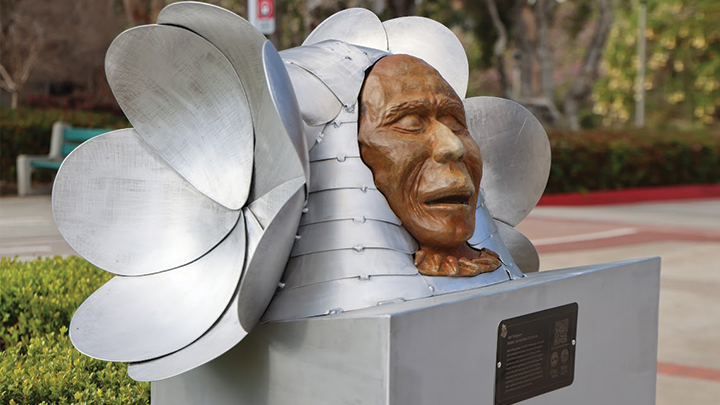SDSU Unveils New Campus Sculpture, Initiating Implementation of Land Acknowledgment
Recited at convocation, commencement and special events, and often seen in syllabi and campus email signatures, the Land Acknowledgement was introduced in recognition of SDSU’s respect for the Indigenous people who originally inhabited the land the university now occupies.
The sculpture in front of Hepner Hall, “Stargazer,” is the first installation in SDSU’s planned Living Land Acknowledgement (LLA), an art series with interactive, immersive learning experiences with real-world and virtual components to complement the written and spoken Land Acknowledgement.
“Stargazer” is installed near the Koester Memorial Sundial. Its focal point is a face angled up at the sky, perfectly positioned to do as its title suggests. Attached to “Stargazer” is a QR code that, when scanned, will lift viewers into an immersive virtual reality lesson about Kumeyaay bird songs, a rich and important component of storytelling and legacy keeping in the Kumeyaay culture.
“It’s beautiful that we acknowledge the first people of this land and we wanted to embed something that allows our students on campus to say, ‘Hey, what’s that?’” said Jacob Alvarado Waipuk, Chair of Tribal Relations at SDSU. “And they click on it and they’re going to get a virtual look into the Kumeyaay. It allows people to discover the land acknowledgment rather than having it fed to them.”
SDSU is targeting the fall 2024 semester for a celebration formally introducing the Living Land Acknowledgement to the campus community and beyond. More information will be shared at a later time.
A map showing proposed locations of art included in Phase 1 of the Living Land Acknowledgment project
By the time the Living Land Acknowledgement is completed in December 2024, six sculptures, all designed by Kumeyaay artist Johnny Bear Contreras, will grace significant, high-traffic areas around campus, chosen with input from students with the Native Resource Center, as well as other stewards of SDSU’s relationship with the Kumeyaay community.
“This isn’t just about the art pieces. It’s about the QR code. That’s going to be the doorway, that’s going to be the window, the access to stories, to songs that have been on this part of the continent since time immemorial,” Contreras said. “I’m hoping that as an individual scans the QR code and listens to the story, that they will be able to see how this piece embraces the stories and the traditions, as we often say, the customs and traditions of the Kumeyaay, the Ipai people.”
All of the sculptures will include a QR code that reveals an extended-reality lesson tied to Kumeyaay culture and history, and the series of art will combine to form a self-guided tour, or a living learning experience, touching several topics and customs paramount in understanding the Kumeyaay way of life, including land agreements, important natural resources, creation stories, medicine and cosmology.
The Living Land Acknowledgement is the result of a collaboration between the Native Resource Center, SDSU Story Lab, the Virtual Immersive Teaching and Learning Research Center and the Division of Student Affairs and Campus Diversity.
More Living Land Acknowledgement artwork is planned for SDSU Imperial Valley, and a series of stand-alone QR codes tied to virtual experiences is planned for walking paths at the SDSU Mission Valley river park.

